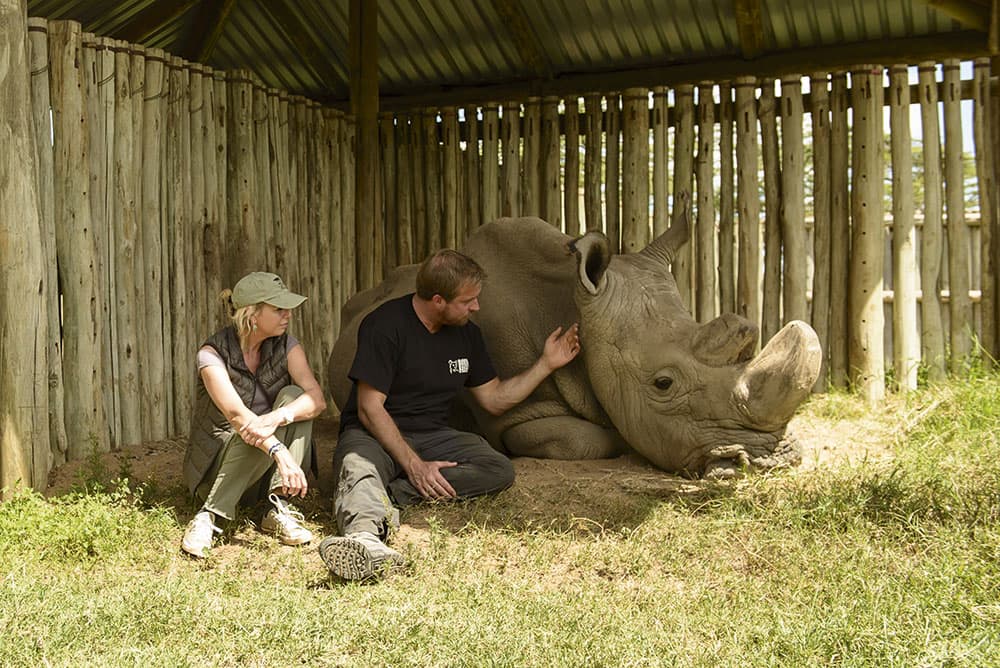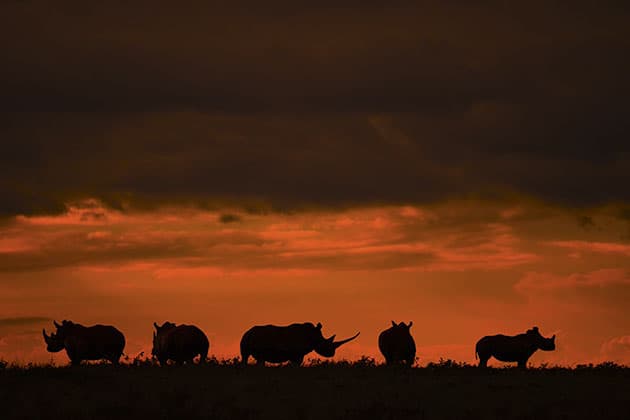
Five Southern White rhinos silhouetted against a blood red sky, South Africa
It seems fitting that a project such as Remembering Elephants should arise from a conversation between two people at the Royal Geographical Society headquarters in London. The Society has long been associated with big ideas and adventurous souls including Sir Ernest Shackleton, Captain Robert Falcon Scott and Sir Edmund Hillary. On this occasion those gathered were at the RGS to support wildlife photographer David Lloyd as he launched his new book As Long As There Are Animals in October 2014.
Partway through the event, photographer Margot Raggett got chatting to Keith Wilson, founder and former editor of Wild Planet Photo Magazine. Before long she was telling him about her plan to produce ‘the most beautiful book about elephants ever made’. ‘Margot had a clear idea of what she wanted,’ explains Keith. ‘Her idea was to get wildlife photographers to donate an image, put them in a book, sell the book, and give the money to charities working to protect elephants and fight ivory poaching.’ Like all of the best ideas, it was a simple one, but she needed someone to help her source the images, persuade photographers to take part, and ensure the finished article was the very best it could be. ‘Margot had never produced a book before,’ says Keith. ‘She wanted high-quality printing and high production values, and she asked if I could help.’ Of course, he said yes.
Between them, the pair approached more than 50 established photographers. ‘Some sent in a selection of pictures; others sent one and kind of suggested, “there it is, take it or leave it” – the higher up the pecking order you went the more this happened,’ laughs Keith. The final line-up included Art Wolfe, Frans Lanting, Jonathan & Angela Scott, and Greg du Toit. ‘In the end we had eight overall winners of the Wildlife Photographer of the Year competition involved,’ he recalls. But these award-winning professionals were not the only ones to appear in the book; there was a twist in the tale. Margot and Keith launched a competition inviting members of the public to send in their images of elephants in the wild – the prize was a chance to appear in the publication.

Remembering Rhinos founder Margot Raggett and actor Dan Richardson, a Born Free ambassador, sit with Sudan, the world’s last male Northern rhino
Making the cut
The competition attracted more than 1,000 entries, and was judged by Keith, Margot, Greg du Toit and David Lloyd. The team could only choose 10 for the book, but the final product contained pictures from 65 photographers. Working with images from so many different sources proved to be a challenge. ‘A large part of my role was to somehow construct a visual narrative out of all these different pictures,’ recalls Keith. ‘I had to produce a book that had a cohesive story, but with so many different styles and formats it was unlike anything I had done before.’
Luckily Keith was gifted the perfect opener in the form of Daryl Balfour’s pictures of an elephant giving birth. In this instance the team was prepared to break the self-imposed ‘one image per photographer’ rule and included six of Daryl’s photographs. The book ends with the tragic loss of Satao, one of Kenya’s most beloved elephants, killed by poachers for his magnificent tusks. ‘Very few elephants die naturally now,’ says Keith. ‘The poachers tend to get to them first.’
According to Keith, the plight of elephants in the wild is as grim as ever. ‘The last great – for want of a better word – poaching crisis was in the 1980s, and was followed by an ivory ban in most countries in Africa,’ he reveals. ‘Back then there were more than a million elephants in Africa, and now there are probably less than 400,000.’ With the rate of poaching exceeding the birth rate, the population is in serious decline. ‘We’re seeing about one elephant being poached every 15 minutes,’ says Keith. ‘We’re not talking about extinction in our children’s lifetimes; we’re talking about it in our own – in the foreseeable future.’
Part of the problem lies in enforcing the laws designed to protect these animals. There are parks that are ‘protected’ by legislation, but if this is not enforced on the ground (in the form of rangers etc) then this label is meaningless. Such places are known as ‘paper parks’.

A rare forest elephant bathing in a river, Republic of Congo
Kickstarting the campaign
On the plus side, projects such as Remembering Elephants raise awareness, and encourage people to play a part in forcing change.
Converting awareness into action is a big leap, however, so the team decided to make it easy for as many people to contribute as possible. They launched a Kickstarter campaign to cover the cost of publishing the book. The target was £20,000, but the total raised so far stands at more than £130,000. ‘We reached our target in less than 24 hours,’ enthuses Keith. So having raised enough money to create a book that would meet Margot’s exacting standards, the pair forged ahead with their idea. With their costs more than covered they were able to donate 100% of book sales to projects of their choosing managed by the Born Free Foundation.
The project was a great success and created such momentum that Keith and Margot were keen to repeat the exercise with another animal in plight – the rhino. Again, the Kickstarter campaign proved extremely fruitful, and by the time it finished in March this year more than £100,000 had been pledged. ‘We can print more books this time,’ smiles Keith. (The team also plans to reprint Remembering Elephants,which completely sold out just before Christmas last year.)
Sadly the plight of the rhinoceros is even more serious than that of the elephant, as Keith reveals. ‘The book opens with a picture of a sub-species of white rhino called the Northern white rhino – there are only three left, and they are under armed guard in Kenya. These animals are beyond breeding age, so they will probably be extinct in a few years. We wanted to show people what extinction really looks like – that you can sit down with this massive prehistoric creature and realise it’s the last one.’

Southern White rhino photographed at night, South Africa
Solitary species
In order to drum home the message, Keith and Margot decided not to focus solely on African rhinos (of which there are two species: black and white), but to include the three Asian species (greater one-horned, Sumatran and Javan) as well.
Thanks to conservation efforts, the first of these animals has been enjoying something of a comeback, with numbers increasing from 600 in the 1970s to 3,500 in mid-2015. But it’s a different story for its cousins. There are thought to be less than 100 Sumatran rhinos left and less than 60 Javan. ‘They are in a precarious situation,’ warns Keith. ‘The issue of extinction is staring us straight in the face.’
Finding photographers with pictures of these critically endangered animals has not always been easy. ‘Sumatran rhinos are probably the hardest to photograph because they are very solitary,’ explains Keith. ‘They are just trying to survive in jungle that is being cleared for palm oil plantation.’
Groundbreaking images
Once again, the list of people contributing to the book is impressive and includes Mark Carwardine, Britta Jaschinski (who has been photographing the illegal wildlife trade for more than 20 years), and Steve Winter. Keith’s eyes light up when he tells me he recently received some images of a white rhino giving birth in the wild. ‘The photographer sent them over as she was witnessing the event,’ he grins. ‘No other photographers have got that, so we are thrilled.’
The competition to win one of 10 places in Remembering Rhinos has recently closed, and Keith is anticipating some pleasant surprises once the judging begins. ‘Last time, one of the competition winners went on to train as a ranger,’ he explains. Her name is Denise Eriksson, and it’s her shot of a rhino that will grace the cover of the latest book. The publication will be released in October and accompanied by an exhibition at La Galleria in London. ‘This is a real example of photography helping conservation,’ says Keith, ‘and, who knows, there may be more to come. So long as it keeps delivering, we will keep doing this.’

Remembering Rhinos will be available in October. Visit www.rememberingrhinos.com. Remembering Elephants sold out just before Christmas, but there are plans to reprint it. Visit www.rememberingelephants.com.








